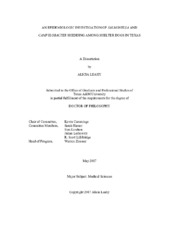| dc.description.abstract | Salmonella and Campylobacter are bacterial pathogens frequently affecting both humans and animals. Even so, there is limited information concerning the epidemiology of these pathogens among canines. Dogs are capable of shedding the bacteria in their feces, often without overt signs of infection. As a result of their close contact with people, dogs could thus play a significant role in disease transmission, exposing their human companions to the bacterial pathogens. In order to fully assess this risk and implement efficacious means of disease control and prevention, however, it is essential to have a more comprehensive understanding of pathogen distribution and determinants as they relate to canine populations. To that end, the present research investigated the epidemiology of Salmonella and Campylobacter fecal shedding among shelter dogs across Texas using both culture-based and molecular methods. Culture detected Salmonella in 27 (5%) of the 554 samples. Salmonella isolates were of many different serotypes, five of which have been among top 10 serotypes isolated from human patients with laboratory-confirmed salmonellosis in the United States. Antimicrobial resistance among the isolates was minimal. Data analysis suggested that fecal consistency may be an indicator of the fecal presence of Salmonella, and that the effects of dog neuter status and dog origin deserve further attention.
For Campylobacter, qPCR suggested a bacterial prevalence of 76% (140 of the 185 samples). Nonetheless, prevalence of two main human pathogens—Campylobacter coli and Campylobacter jejuni—was undetected or low, at 0% and 5.4%, respectively. Statistical assessment of putative shedding indicators demonstrated a possible relationship between the presence of fecal Campylobacter, dog sex, and dog duration of stay in shelter.
Campylobacter detection was heavily dependent on the detection method(s) employed. The qPCR method used in the present research proved to be much faster and more sensitive relative to various culture-based techniques. As such, qPCR may be most useful as an adjunct to bacterial culture, perhaps serving to guide selection of an optimal approach to culture. Integral to any approach, however, must be the recognition that canines are clear participants in Salmonella and Campylobacter epidemiology, and their contributions hold substantial import for their close companions. | en |


